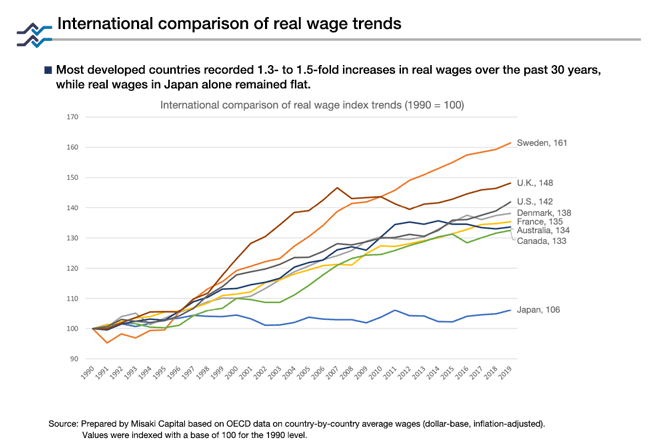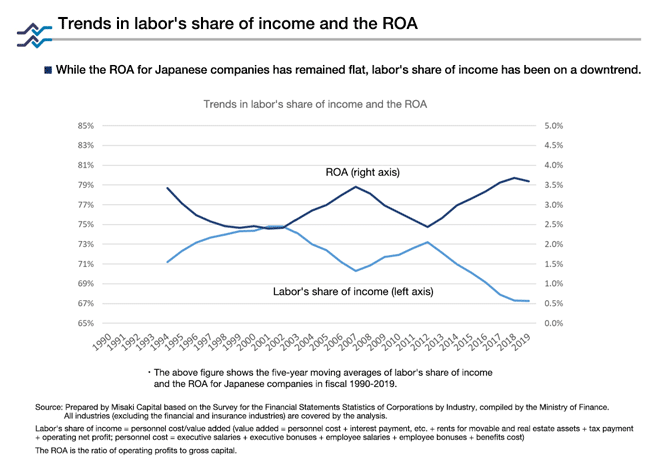Around one year ago (December 12, 2019), many Japanese people were shocked by an article in the Nihon Keizai Shimbun newspaper, which title was "Families with Annual Income of Less than 10 Million Yen Regarded as a Low-Income Class"—.
The article referred to a survey by the U.S. Department of Housing and Urban Development, which said four-person families with an annual income of 14 million yen were included in the 'low-income category' in San Francisco. The article also referred to the Japanese situation citing to the data from the Ministry of Health, Labour and Welfare, that the average annual household income in Japan in 2017 was around 5.5 million yen, with only just over 10% of all households earning 10 million yen or more."
This means that Japan's wealthy class, or families among the top 10% in terms of household income in the country, correspond to the low-income category in San Francisco. San Francisco is an affluent city, to be sure (as I know well from my experience living near the city as a foreign student). We may argue that San Francisco is an exceptionally affluent city by global standards, riding high on the rise of the information technology (IT) industry and comparing the Japanese average to an exceptional city like San Francisco would be meaningless. We may conclude that the Japanese people are still affluent enough. However, there other disquieting data showing that Japan is falling further behind the rest of the world.
Facing Up to the Reality: "The Japanese People Are Becoming Poorer and Poorer (Relative to the Rest of the World)"
Among various economic statistics published by the Organization for Economic Cooperation and Development (OECD), the trend in real wages by countries, for example, was also shocking. Most developed countries recorded 1.3- to 1.5-fold increases in real wages over the past 30 years, while Japan was an exception, registering an increase of only around 6%. Indeed, the Japanese people might rarely have felt any improvement in their wealth in everyday lives. Although prices have risen in other countries, wages have increased at a higher pace. As a result, the people in those countries might have realized that their wealth have risen through their daily lives.

[Click to enlarge]
Perhaps "Other data also point to the troubles facing us in Japan." ...would be more appropriate. The analysis of labor's share of income and the return on assets (ROA) based on the Survey for the Financial Statements Statistics of Corporations by Industry gives the following picture: "The ROA for Japanese companies has remained flat, while labor's share of income has been on a downtrend for many years. In other words, Japanese companies have just managed to keep profits while cutting back on payment to workers." If I take a look at the different angle, renumeration to the shareholder, the picture did not look great and it was not quite true that companies have brought wealth to shareholders using profits earned at the expense of employees.
It is still fresh in our memories that the "20-million-yen problem" ("Set aside 20 million yen or more for post-retirement life, or else.") created much controversy against the backdrop of the sluggish performance of pension asset investments, which are supposed to provide a financial cushion in old age.

[Click to enlarge]
Labor's share of income = personnel cost/value added (value added = personnel cost + interest payment, etc. + rents for movable and real estate assets + tax payment + operating net profit; personnel cost = executive salaries + executive bonuses + employee salaries + employee bonuses + benefits cost)
The ROA is the ratio of operating profits to gross capital.
"ESG" (environmental, social and governance) issues have become a popular agenda in public and the "purpose" of a company is being questioned. However, what we must face up to at the moment is the reality that nobody among all business stakeholders became affluent in Japan, which is the major "S" (social) issue for the Japan.
Of course, "E" (environmental), represented by climate change, and "G" (governance) are also important. However, I believe that unless this "S" (social) issue that the Japanese people are getting poorer is resolved, the Japanese economy as a whole cannot be revitalized.
Something is going wrong in the Japanese Model of Management
Even though I am not an expert in economics, I can understand that the very basic principle of economics is that companies are engines of the economy. There are various economic constituents, but only companies actually create wealth for our society. Households and the government are entirely dependent on the benefits that come from the wealth that is created by companies.
I also think it is management that acts as engines for companies, which I have realized from my experience being involved in the development of business strategies as a management consultant for many years and in evaluating business strategies as a long-term investor afterward:
Good management alone generates high profits, increases everyone's income, and leads to an increase in the value of assets in the form of higher stock prices at the same time. There is no alternative mechanism that increases affluence for all stakeholders.
The flipside of this formula is that bad management depresses profits, reduces everyone's income, and lowers stock valuations.
Although this formula may be very simple, it is unquestionable.
If the proposition that "becoming a business stakeholder has made nobody affluent in Japan" is correct, the conclusion must be that there is something wrong with the Japanese model of management.
Incorporate Concepts and Techniques Used by Selective Investors
If there is something wrong with the conventional wisdom of management, an unconventional approach must be necessary. My proposal is to incorporate concepts and techniques used by "selective investors" into management, in order to resolve this "S" issue. This is very different from the conventional approach.
Selective investors are investors who find companies whose excellence is, to use statistical terminology, above the "2σ" (equivalent to a deviation value of 70) level and bet their money on the superiority of those companies' management so that they can survive the rough and tumble of the stock market over an extended period of time. Although companies with an excellence level above "1σ" (equivalent to a deviation value of 60) would be normally regarded as fairly good companies, selective investors have no regard for them.
Although they may have no experience being involved in management, selective investors choose companies based on the "2σ" threshold as their yardstick for evaluation. I believe that this strict selection standard regarding management excellence provides clues for upending the conventional wisdom of management in Japan and dramatically raising profitability and corporate value.
Practical Steps Toward Bringing Affluence to Everyone
Until now, investors have been unable to exert significant influence on Japanese corporations. This means precisely that selective investors' concepts and techniques have not become incorporated. In this situation, I see ample potential for the evolution of management. It is possible to raise the level of management markedly by incorporating selective investors' concepts and techniques, including "compound interest," "excess profit," "business economics," and "barriers."
My vision of management is this: develop a "trinity" model that includes selective investors into the traditional Japanese model of management, which managers and employees have developed together as partners with a shared sense of mission; and provide an understanding of the selective investors' selection standards regarding management excellence, and apply the new model to the actual management of Japanese companies. I have distilled this vision of management into practical steps that can be replicated by anybody, by summarizing the case examples of companies that brought affluence not only to shareholders but to all stakeholders, including managers and employees.—My proposal is based on the stories that I have encountered in my work on the frontlines of investment.
The practical steps that I propose are as follows (for further details, please refer to my book Trinity Management (Diamond Inc.):
- (i) First, managers and employees should secure sufficient ownership of shares in their own companies. Raising the percentage of shares held by company insiders in Japan, which is low by global standards, will pave the way for enjoying the long-term benefits of management innovation.
- (ii) Sufficient ownership of shares increases the employees' sense of participation in management. Also, in addition to bringing together employees' and managers' knowledge at the management level, it is essential to raise profitability and corporate value by combining that knowledge with selective investors' concepts and techniques.
- (iii) Managers, employees and selective investors will together enjoy the long-term benefits of management innovation and receive sufficient economic rewards, thereby moving toward the goal of resolving the major "S" (social) issue (the absence of people who have achieved affluence by becoming a business stakeholder).
Establishing a New Japanese Model of Management
At present, many people are struggling with the coronavirus crisis. In the current economic environment, where demand has evaporated and supply value chains have been disrupted, it is difficult to envision a path whereby everyone becomes affluent by depending only on income flows, such as wages and bonuses, as we have done until now. By making smart use of share ownership, which is a fundamental tool of capitalism (although it has been shunned in Japan), perhaps we can find a solution to the major social challenge that is inherent in the Japanese economy. Perhaps we can open a new path whereby everybody can become affluent by making a bold shift from the traditional Japanese model of management, which has been nurtured through cooperation between managers and employees as partners with a shared sense of mission, to a "trinity" model of management, which also enlists the expertise of super-selective investors.
It was with ideas like these in mind that I celebrated the arrival of the new year.


